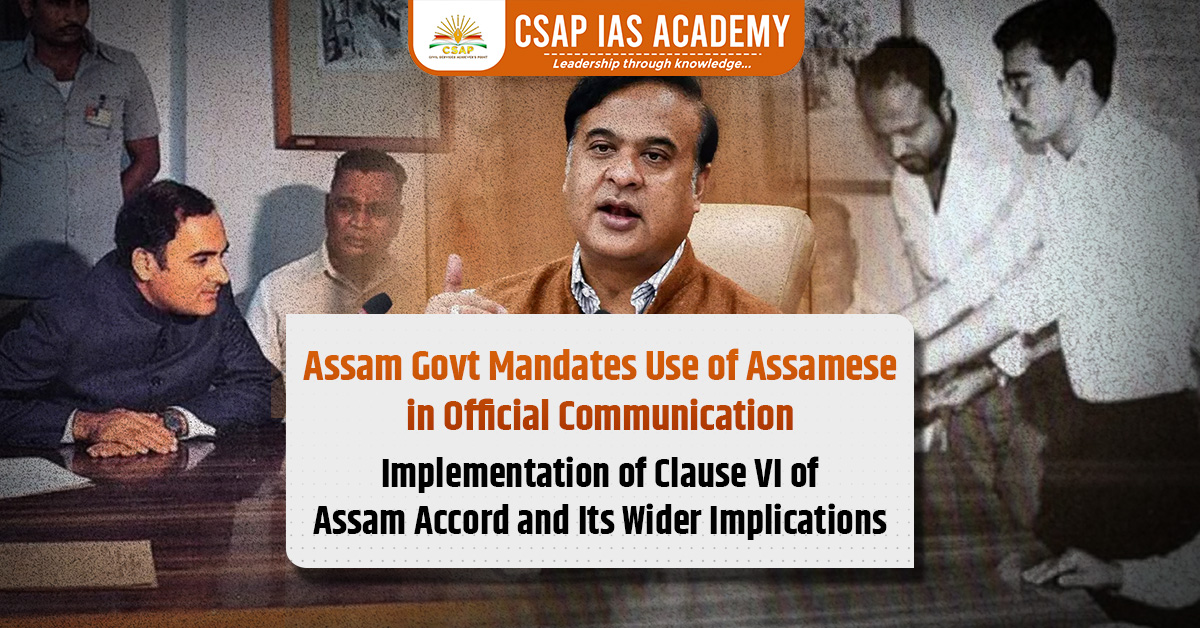On the occasion of Rongali Bihu and Assamese New Year, the Assam government took a significant step towards preserving the cultural and linguistic identity of the indigenous Assamese population by making the Assamese language mandatory in all official communication, alongside English. Chief Minister Himanta Biswa Sarma announced the directive through a post on social media platform X, stating that the move aligns with the long-pending demands and aspirations of the Assamese people.
Background: Assam Accord and Clause VI
The decision is rooted in the implementation of Clause VI of the historic Assam Accord of 1985. The Assam Accord was signed between the Government of India and the All Assam Students’ Union (AASU) after a six-year-long anti-foreigner movement in Assam. Clause VI specifically deals with constitutional, legislative, and administrative safeguards to protect and preserve the cultural, social, and linguistic identity and heritage of the Assamese people.
To recommend steps for implementing Clause VI, the Government of Assam had constituted a high-level committee under the chairmanship of retired Justice Biplab Kumar Sarma. The committee submitted a set of 52 recommendations, one of which was the mandatory use of Assamese in official matters.
Key Highlights of the Directive
- The directive applies to all government departments, offices, and institutions under the Assam Government.
- All official notifications, office memoranda, acts, rules, regulations, schemes, and transfer/posting orders will now be issued in both Assamese and English.
- Bengali will be used in official communication in the Barak Valley, and Bodo will be used in the Bodoland Territorial Region (BTR), ensuring inclusivity of linguistic minorities.
- The Assam Official Language Act, 1960 has been invoked to give effect to the mandate through the Governor’s notification.
Significance of Making the Assamese language mandatory
- Linguistic Identity Protection: This directive is a major cultural assertion aimed at securing Assamese as the dominant administrative and cultural language of Assam.
- Cultural Preservation: The move is seen as a proactive measure to ensure the Assamese language does not lose its relevance in the face of globalization and increasing urbanization.
- Administrative Inclusivity: By including Bengali in Barak Valley and Bodo in BTR, the directive reflects a nuanced and inclusive approach to Assam’s ethnolinguistic diversity.
- Implementation of Accord Promises: It marks a concrete step towards fulfilling the decades-old promises made under the Assam Accord, which had remained largely unimplemented till now.
Challenges and Concerns in making Assamese language mandatory
- Capacity and Infrastructure: The effective implementation of this directive will require capacity building in terms of translation, staff training, and development of bilingual official forms and databases.
- Public Reception: While many Assamese-speaking citizens welcome the move, concerns may arise from other linguistic communities regarding perceived marginalization.
- Digital Integration: Transitioning digital platforms, mobile apps, and e-governance portals to support Assamese and other local languages will require significant investment and planning.
- Legal Implications: Ensuring all legal documents and administrative records are error-free in both languages will be a major task for government departments.
Broader Implications
The Assam government’s move could set a precedent for other states to prioritize regional languages in governance. It also aligns with the spirit of the New Education Policy (NEP) 2020, which encourages education and administration in mother tongues and local languages.
This directive strengthens cooperative federalism by allowing linguistic diversity within the constitutional framework of India. It also adds momentum to the broader discourse on linguistic nationalism and the role of language in identity politics.
Conclusion
The making of Assamese language mandatory in official communication marks a significant milestone in Assam’s socio-political journey. While it reaffirms commitment to preserving Assamese identity, it must be implemented with sensitivity, ensuring inclusiveness and effective administration across all regions of the state. The successful realization of this policy will depend on robust planning, adequate resources, and widespread public cooperation.
Read: National Critical Mineral Mission
Download App:










